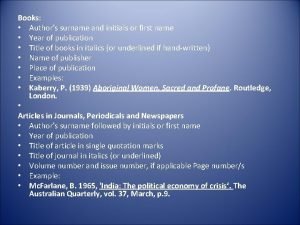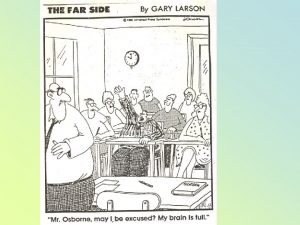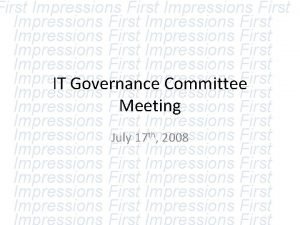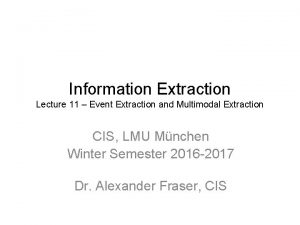IN THE NAME OF GOD EXTRACTION OF FIRST
































- Slides: 32

IN THE NAME OF GOD EXTRACTION OF FIRST PERMANENT MOLARS Dr: Nahvi


� THE EFFECT OF LOSS OF THE FIRST PERMANENT MOLAR � Diminished local function � Drifting of teeth � Continued eruption of opposing teeth � Midline deviation � Increasing overbite Shaheed Beheshti University of Dental Journal

FACTORS TO CONSIDER WHEN PLANNING EXTRACTION OF FIRST PERMANENT MOLARS �the restorative state of the tooth �presence and condition of the other teeth � dental age of the patient �the occlusal relationship Dental update 2001

the restorative state of the tooth

presence and condition of the other teeth • If any are absent, extraction of the first permanent molar in that quadrant should be avoided. � The absence of third molars does not generally contraindicate the extraction of FPMs. However, the presence of mesially directed forces from developing third molars may aid space closure. Dental update 2001

presence the other teeth(same quadrant) No yes

dental age of the patient � Ideal time to extract first molar is 8. 5 -10 years � Earlier extraction : second premolar have a tendency to drift distally � Delayed extraction : the second molars will show less bodily movement and more tilting Journal of dentitry Tehran university of medical sciences 2002

Mcdonald 2011

A greater degree of movement will occur in children in the 8. 5 to 10 year age group radiographic evidence of early dentine calcification within the second molar root bifurcation Journal of dentitry Tehran university of medical sciences 2002

Dental calcification stages(Nolla)

Radiographs taken at 6 -month intervals after the loss of a maxillary first molar Mcdonald 2011

After extraction of the mandibular primary teeth and first permanent molars 3. 2 years after extraction of the first permanent molars



dental age of the patient In maxilla Permane nt dentition 7 -11. 5 dental age of the patient in mandible other s 8. 510

The occlusal relationship �class I �with labial segment crowding �with buccal segment crowding Dental update 2001

�class II division 1 �class II division II �extractions in the lower arch should be avoided if at all possible in deep bite cases �class III Dental update 2001

class II division class I 1 mandibl e maxilla labial segment crowding class II division II mandible maxilla buccal segment crowding class III mandil e maxilla

Ideal condition �presence and condition of the other teeth �class I �with buccal segment crowding �In children in the 8. 5 to 10 year age group

Balancing and compensating extractions Compensating involves extraction of an antagonistic molar to prevent its overeruption of the upper FPM can prevent mesial migration of the mandibular second permanent molar. Balancing involves removal of a contralateral tooth, which needn’t necessarily be a FPM, to preserve the dental midline. Dental update 2001

One carious first permanent molar BRITISH DENTAL JOURNAL 2001

One carious first permanent molar (Upper) mandibl e maxilla One carious first permanent molar (lower) mandibl e maxilla

Two carious first permanent molars BRITISH DENTAL JOURNAL 2001

Two carious first permanent molars (lowers) Two carious first permanent molars (uppers) mandible maxilla One upper and one lower(different sides) mandibl e maxill a maxilla

Three carious first permanent molars BRITISH DENTAL JOURNAL 2001

Three carious first permanent molars Maxilla and mandible

Prevalence of Loss of Permanent First Molars in a Group of Romanian Children and Adolescents �Anca Maria Rãducanu, Victor Feraru Distribution of loss of permanent first molars by quadrant. OHDMBSC, 2009

Effects of early loss of permanent first molars on the development of third molars �Panoramic radiographs and dental casts of 165 adolescent patients (103 boys, 62 girls) with unilateral early loss of a permanent first molar were used to assess the developmental stages of the third molars. The formation stages of third molars on the extraction sides were evaluated, and the formative conditions of the contralateral teeth were used as controls. Early loss of the permanent first molars might have an accelerating effect on the development of the third molar on the extraction side compared with the contralateral teeth. Therefore, emergence of the third molars on the extraction side might be hastened, and these teeth might erupt earlier than the contralateral teeth.

Evaluation of spontaneous space closure and development of permanent dentition after extraction of hypomineralized permanent first molars BIRGITTA JÄLEVIK & MARIE MÖLLER Twenty-seven children who had one to four permanent first molars extracted due to severe MIH. Each case was followed up on individual indications 3. 8– 8. 3 (median 5. 7) years after extractions. The eruption of the permanent dentition, and space closure were documented by orthopantomograms, casts, photographs, and/or bitewings. Fifteen children were judged to have a favourable spontaneous development of their permanent dentition without any orthodontic intervention. Seven children were or should be subjected to orthodontic treatment for other reasons registered prior to the extraction. Five International children were Journal judged of to Paediatric have a treatment at least caused by 2007 the extractions, but three of them Dentistry

7. 7 8. 8 7, 7 10. 2 13. 8 International Journal of Paediatric

Thank You
 God's promises
God's promises Authors by initials
Authors by initials Hello good morning what's your name jenny
Hello good morning what's your name jenny First name last name tpu
First name last name tpu Name
Name Hát kết hợp bộ gõ cơ thể
Hát kết hợp bộ gõ cơ thể Lp html
Lp html Bổ thể
Bổ thể Tỉ lệ cơ thể trẻ em
Tỉ lệ cơ thể trẻ em Gấu đi như thế nào
Gấu đi như thế nào Chụp tư thế worms-breton
Chụp tư thế worms-breton Alleluia hat len nguoi oi
Alleluia hat len nguoi oi Môn thể thao bắt đầu bằng từ chạy
Môn thể thao bắt đầu bằng từ chạy Thế nào là hệ số cao nhất
Thế nào là hệ số cao nhất Các châu lục và đại dương trên thế giới
Các châu lục và đại dương trên thế giới Cong thức tính động năng
Cong thức tính động năng Trời xanh đây là của chúng ta thể thơ
Trời xanh đây là của chúng ta thể thơ Mật thư anh em như thể tay chân
Mật thư anh em như thể tay chân 101012 bằng
101012 bằng độ dài liên kết
độ dài liên kết Các châu lục và đại dương trên thế giới
Các châu lục và đại dương trên thế giới Thể thơ truyền thống
Thể thơ truyền thống Quá trình desamine hóa có thể tạo ra
Quá trình desamine hóa có thể tạo ra Một số thể thơ truyền thống
Một số thể thơ truyền thống Cái miệng bé xinh thế chỉ nói điều hay thôi
Cái miệng bé xinh thế chỉ nói điều hay thôi Vẽ hình chiếu vuông góc của vật thể sau
Vẽ hình chiếu vuông góc của vật thể sau Biện pháp chống mỏi cơ
Biện pháp chống mỏi cơ đặc điểm cơ thể của người tối cổ
đặc điểm cơ thể của người tối cổ Thế nào là giọng cùng tên
Thế nào là giọng cùng tên Vẽ hình chiếu đứng bằng cạnh của vật thể
Vẽ hình chiếu đứng bằng cạnh của vật thể Vẽ hình chiếu vuông góc của vật thể sau
Vẽ hình chiếu vuông góc của vật thể sau Thẻ vin
Thẻ vin đại từ thay thế
đại từ thay thế
























































